Abstract
Surveillance is the foundation of public health practice. This review examines the experience of surveillance in the Expanded Programme on Immunization (EPI). Surveillance systems include routine reporting, sentinel surveillance, and community-based reporting. Data from ongoing surveillance should be linked with those from supervision, health facility assessments, population surveys, and outbreak investigations to provide information for programme planning, implementation, evaluation, and modification. Evaluation of surveillance systems should assess the extent to which data are used for policy-making and programme improvement, and the simplicity, accuracy, completeness, timeliness and cost of the data. The surveillance of vaccine-preventable diseases has evolved as programmes mature, to monitor progress towards disease control targets. The establishment of goals to reduce measles cases by 90%, eliminate neonatal tetanus, and eradicate poliomyelitis has put increased emphasis on the need for effective disease surveillance. This opportunity should be taken to promote strengthening of national routine systems for disease surveillance, to make them effective instruments for prevention and control of diseases of public health importance.
Full text
PDF
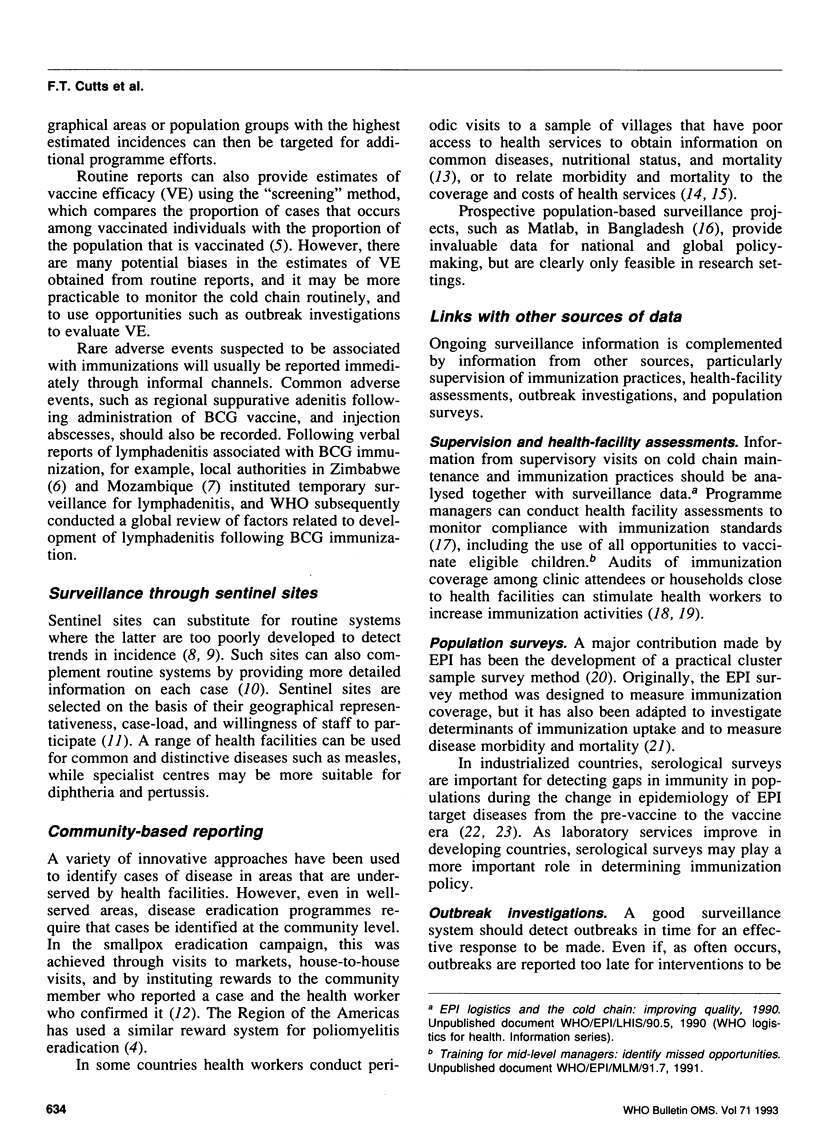
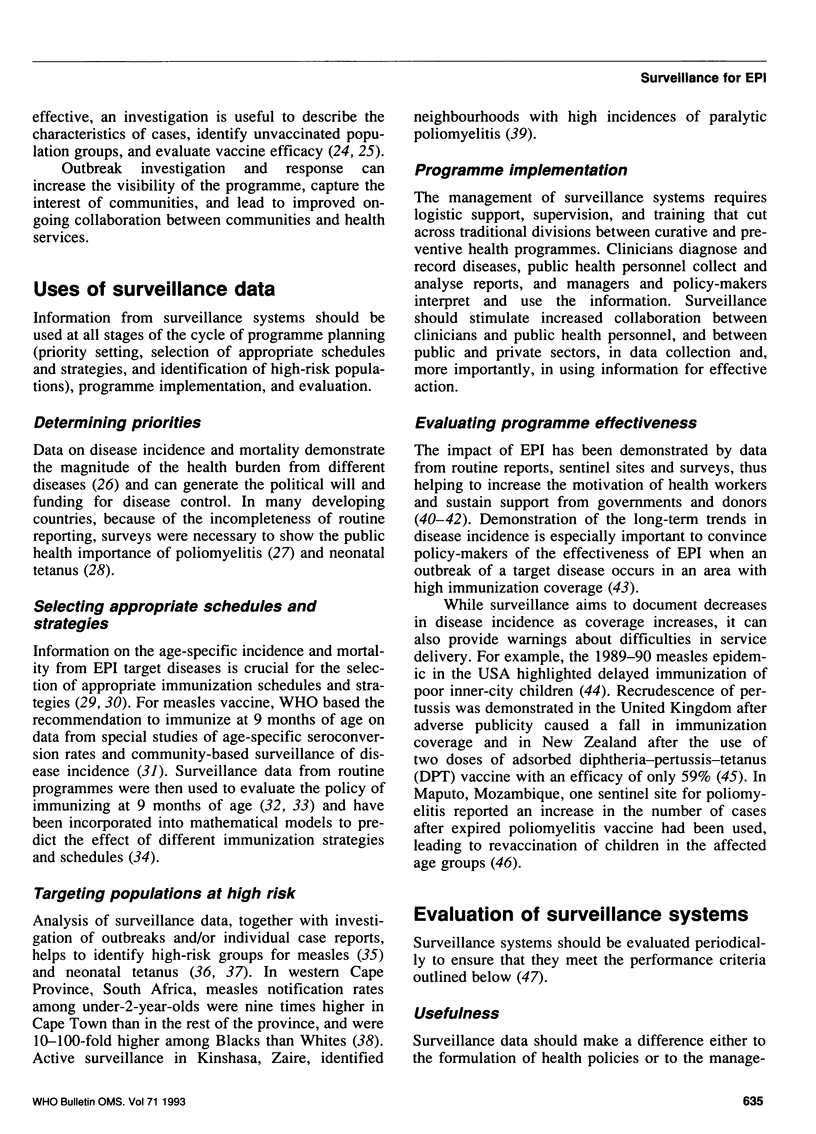
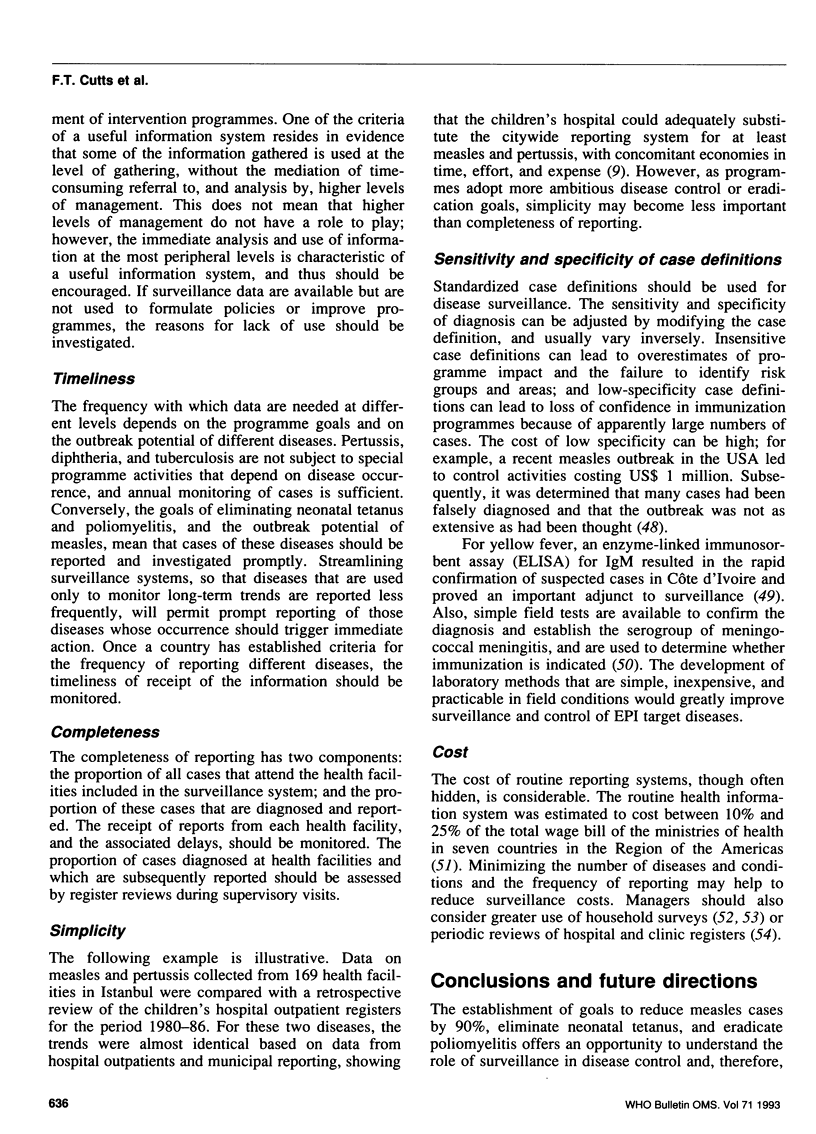
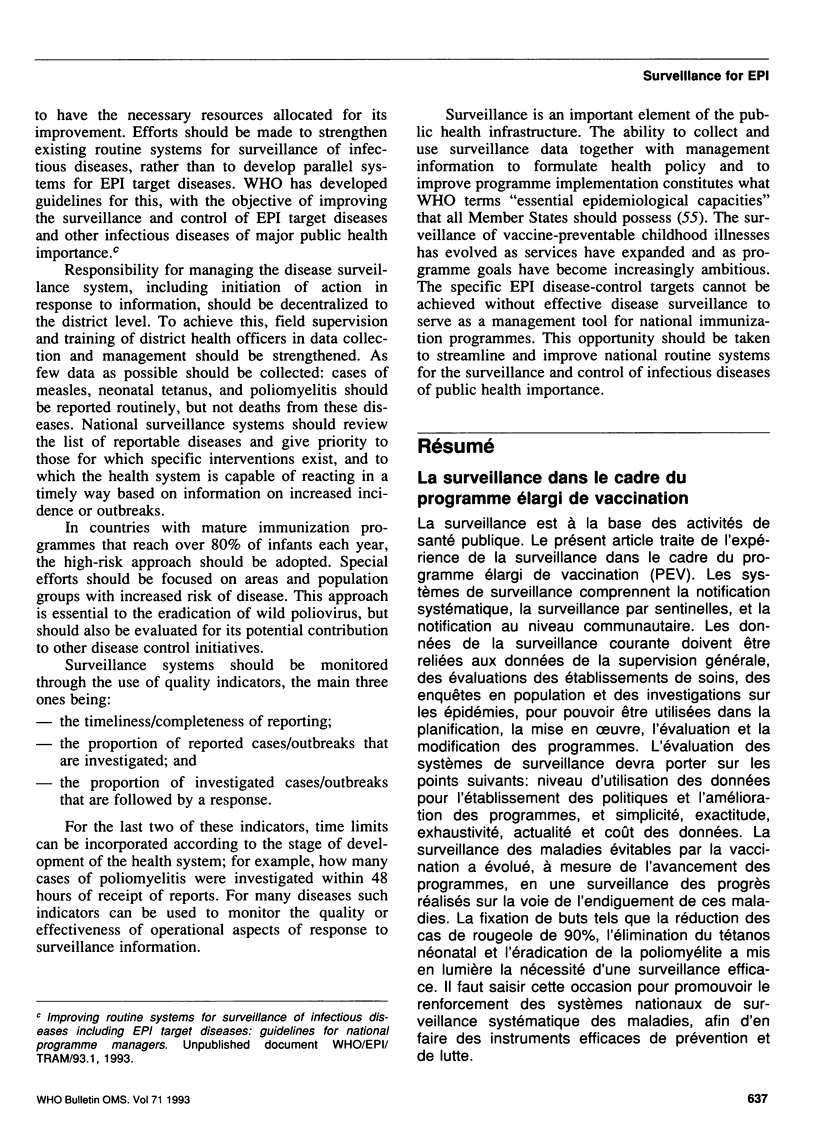
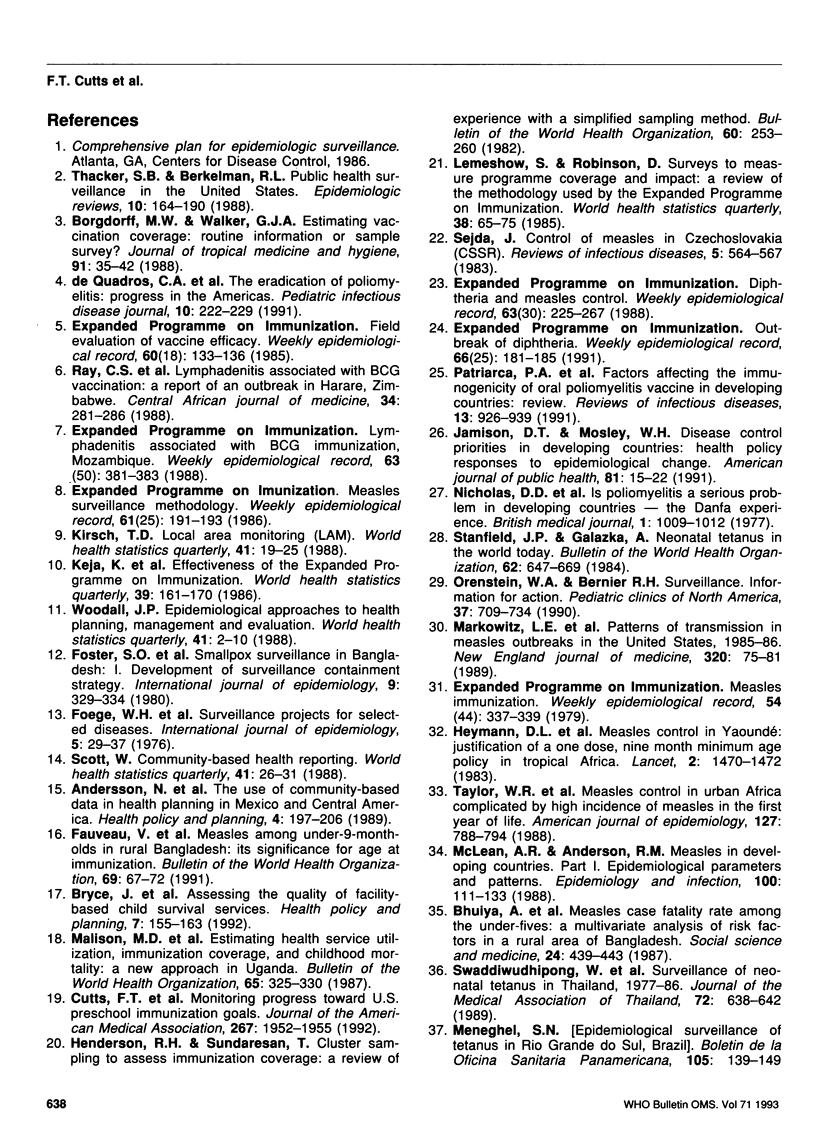
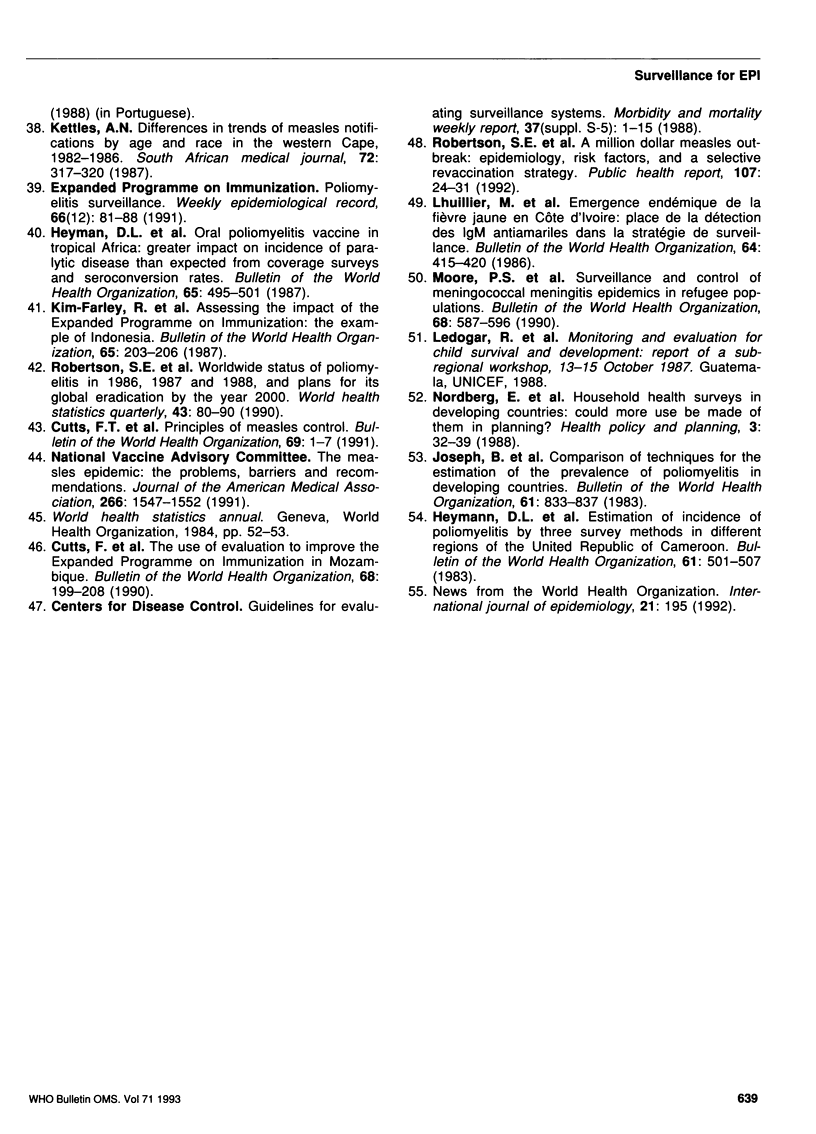
Selected References
These references are in PubMed. This may not be the complete list of references from this article.
- Bhuiya A., Wojtyniak B., D'Souza S., Nahar L., Shaikh K. Measles case fatality among the under-fives: a multivariate analysis of risk factors in a rural area of Bangladesh. Soc Sci Med. 1987;24(5):439–443. doi: 10.1016/0277-9536(87)90217-6. [DOI] [PubMed] [Google Scholar]
- Borgdorff M. W., Walker G. J. Estimating vaccination coverage: routine information or sample survey? J Trop Med Hyg. 1988 Feb;91(1):35–42. [PubMed] [Google Scholar]
- Cutts F. T., Zell E. R., Mason D., Bernier R. H., Dini E. F., Orenstein W. A. Monitoring progress toward US preschool immunization goals. JAMA. 1992 Apr 8;267(14):1952–1955. [PubMed] [Google Scholar]
- Cutts F., Soares A., Jecque A. V., Cliff J., Kortbeek S., Colombo S. The use of evaluation to improve the Expanded Programme on Immunization in Mozambique. Bull World Health Organ. 1990;68(2):199–208. [PMC free article] [PubMed] [Google Scholar]
- De Quadros C. A., Andrus J. K., Olivé J. M., Da Silveira C. M., Eikhof R. M., Carrasco P., Fitzsimmons J. W., Pinheiro F. P. Eradication of poliomyelitis: progress in the Americas. Pediatr Infect Dis J. 1991 Mar;10(3):222–229. doi: 10.1097/00006454-199103000-00011. [DOI] [PubMed] [Google Scholar]
- Fauveau V., Chakraborty J., Sarder A. M., Khan M. A., Koenig M. A. Measles among under-9-month-olds in rural Bangladesh: its significance for age at immunization. Bull World Health Organ. 1991;69(1):67–72. [PMC free article] [PubMed] [Google Scholar]
- Foster S. O., Ward N. A., Joarder A. K., Arnt N., Tarantola D., Rahman M., Hughes K. Smallpox surveillance in Bangladesh: I - Development of surveillance containment strategy. Int J Epidemiol. 1980 Dec;9(4):329–334. doi: 10.1093/ije/9.4.329. [DOI] [PubMed] [Google Scholar]
- Henderson R. H., Sundaresan T. Cluster sampling to assess immunization coverage: a review of experience with a simplified sampling method. Bull World Health Organ. 1982;60(2):253–260. [PMC free article] [PubMed] [Google Scholar]
- Heymann D. L., Floyd V. D., Lichnevski M., Maben G. K., Mvongo F. Estimation of incidence of poliomyelitis by three survey methods in different regions of the United Republic of Cameroon. Bull World Health Organ. 1983;61(3):501–507. [PMC free article] [PubMed] [Google Scholar]
- Heymann D. L., Mayben G. K., Murphy K. R., Guyer B., Foster S. O. Measles control in Yaounde: justification of a one dose, nine month minimum age vaccination policy in tropical Africa. Lancet. 1983 Dec 24;2(8365-66):1470–1472. doi: 10.1016/s0140-6736(83)90813-9. [DOI] [PubMed] [Google Scholar]
- Jamison D. T., Mosley W. H. Disease control priorities in developing countries: health policy responses to epidemiological change. Am J Public Health. 1991 Jan;81(1):15–22. doi: 10.2105/ajph.81.1.15. [DOI] [PMC free article] [PubMed] [Google Scholar]
- Joseph B., Ravikumar R., John M., Natarajan K., Steinhoff M. C., John T. J. Comparison of techniques for the estimation of the prevalence of poliomyelitis in developing countries. Bull World Health Organ. 1983;61(5):833–837. [PMC free article] [PubMed] [Google Scholar]
- Keja K., Chan C., Brenner E., Henderson R. Effectiveness of the Expanded Programme on Immunization. World Health Stat Q. 1986;39(2):161–170. [PubMed] [Google Scholar]
- Kettles A. N. Differences in trends of measles notifications by age and race in the western Cape, 1982-1986. S Afr Med J. 1987 Sep 5;72(5):317–320. [PubMed] [Google Scholar]
- Kim-Farley R., Soewarso T. I., Karyadi A., Adhyatma M. Assessing the impact of the expanded programme on immunization: the example of Indonesia. Bull World Health Organ. 1987;65(2):203–206. [PMC free article] [PubMed] [Google Scholar]
- Kirsch T. D. Local area monitoring (LAM). World Health Stat Q. 1988;41(1):19–25. [PubMed] [Google Scholar]
- Lemeshow S., Robinson D. Surveys to measure programme coverage and impact: a review of the methodology used by the expanded programme on immunization. World Health Stat Q. 1985;38(1):65–75. [PubMed] [Google Scholar]
- Lhuillier M., Sarthou J. L., Cordellier R., Monteny N., Gershy-Damet G. M., Bouchite B. Emergence endémique de la fièvre jaune en Côte d'Ivoire: place de la détection des IgM antiamariles dans la stratégie de surveillance. Bull World Health Organ. 1986;64(3):415–420. [PMC free article] [PubMed] [Google Scholar]
- Malison M. D., Sekeito P., Henderson P. L., Hawkins R. V., Okware S. I., Jones T. S. Estimating health service utilization, immunization coverage, and childhood mortality: a new approach in Uganda. Bull World Health Organ. 1987;65(3):325–330. [PMC free article] [PubMed] [Google Scholar]
- Markowitz L. E., Preblud S. R., Orenstein W. A., Rovira E. Z., Adams N. C., Hawkins C. E., Hinman A. R. Patterns of transmission in measles outbreaks in the United States, 1985-1986. N Engl J Med. 1989 Jan 12;320(2):75–81. doi: 10.1056/NEJM198901123200202. [DOI] [PubMed] [Google Scholar]
- McLean A. R., Anderson R. M. Measles in developing countries. Part I. Epidemiological parameters and patterns. Epidemiol Infect. 1988 Feb;100(1):111–133. doi: 10.1017/s0950268800065614. [DOI] [PMC free article] [PubMed] [Google Scholar]
- Meneghel S. N. Vigilância epidemiológica do tétano no Rio Grande do Sul, Brasil. Bol Oficina Sanit Panam. 1988 Aug;105(2):139–150. [PubMed] [Google Scholar]
- Moore P. S., Toole M. J., Nieburg P., Waldman R. J., Broome C. V. Surveillance and control of meningococcal meningitis epidemics in refugee populations. Bull World Health Organ. 1990;68(5):587–596. [PMC free article] [PubMed] [Google Scholar]
- Nicholas D. D., Kratzer J. H., Ofosu-Amaah S., Belcher D. W. Outside Europe. Is poliomyelitis a serious problem in developing countries?--the Danfa experience. Br Med J. 1977 Apr 16;1(6067):1009–1012. doi: 10.1136/bmj.1.6067.1009. [DOI] [PMC free article] [PubMed] [Google Scholar]
- Orenstein W. A., Bernier R. H. Surveillance. Information for action. Pediatr Clin North Am. 1990 Jun;37(3):709–734. doi: 10.1016/s0031-3955(16)36912-7. [DOI] [PubMed] [Google Scholar]
- Patriarca P. A., Wright P. F., John T. J. Factors affecting the immunogenicity of oral poliovirus vaccine in developing countries: review. Rev Infect Dis. 1991 Sep-Oct;13(5):926–939. doi: 10.1093/clinids/13.5.926. [DOI] [PubMed] [Google Scholar]
- Ray C. S., Pringle D., Legg W., Mbengeranwa O. L. Lymphadenitis associated with BCG vaccination: a report of an outbreak in Harare, Zimbabwe. Cent Afr J Med. 1988 Dec;34(12):281–286. [PubMed] [Google Scholar]
- Robertson S. E., Chan C., Kim-Farley R., Ward N. Worldwide status of poliomyelitis in 1986, 1987 and 1988, and plans for its global eradication by the year 2000. World Health Stat Q. 1990;43(2):80–90. [PubMed] [Google Scholar]
- Robertson S. E., Markowitz L. E., Berry D. A., Dini E. F., Orenstein W. A. A million dollar measles outbreak: epidemiology, risk factors, and a selective revaccination strategy. Public Health Rep. 1992 Jan-Feb;107(1):24–31. [PMC free article] [PubMed] [Google Scholar]
- Sejda J. Control of measles in Czechoslovakia (CSSR). Rev Infect Dis. 1983 May-Jun;5(3):564–567. doi: 10.1093/clinids/5.3.564. [DOI] [PubMed] [Google Scholar]
- Stanfield J. P., Galazka A. Neonatal tetanus in the world today. Bull World Health Organ. 1984;62(4):647–669. [PMC free article] [PubMed] [Google Scholar]
- Swaddiwudhipong W., Warintrawat S., Kunasol P., Sangwanloy O. Surveillance of neonatal tetanus in Thailand, 1977-1986. J Med Assoc Thai. 1989 Nov;72(11):638–642. [PubMed] [Google Scholar]
- Taylor W. R., Mambu R. K., ma-Disu M., Weinman J. M. Measles control efforts in urban Africa complicated by high incidence of measles in the first year of life. Am J Epidemiol. 1988 Apr;127(4):788–794. doi: 10.1093/oxfordjournals.aje.a114860. [DOI] [PubMed] [Google Scholar]
- Thacker S. B., Berkelman R. L. Public health surveillance in the United States. Epidemiol Rev. 1988;10:164–190. doi: 10.1093/oxfordjournals.epirev.a036021. [DOI] [PubMed] [Google Scholar]
- Woodall J. P. Epidemiological approaches to health planning, management and evaluation. World Health Stat Q. 1988;41(1):2–10. [PubMed] [Google Scholar]


